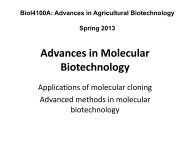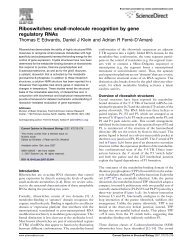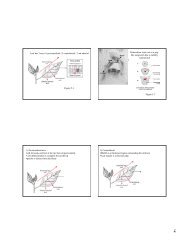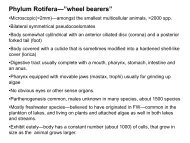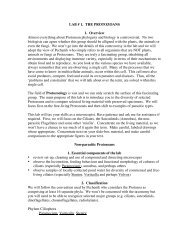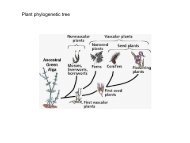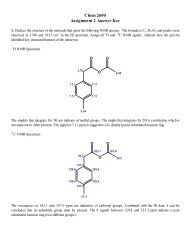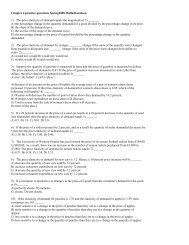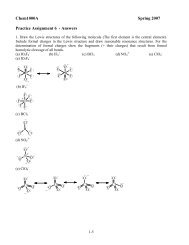The Lipids
The Lipids
The Lipids
You also want an ePaper? Increase the reach of your titles
YUMPU automatically turns print PDFs into web optimized ePapers that Google loves.
<strong>The</strong> <strong>Lipids</strong><br />
Triglycerides<br />
Phospholipids<br />
Sterols<br />
Fats & Oils
Fatty Acids and Triglycerides<br />
Glycerol
Triglycerides<br />
glycerol + 3 fatty acids → triglyceride + H 2O
Fatty acids<br />
Fatty Acids<br />
Chain Length<br />
Chain structure<br />
Saturated<br />
Unsaturated<br />
Cis & trans
Fatty Acids<br />
Length of the carbon chain<br />
Stearic acid – 18 – carbon atoms, saturated<br />
Simplified structure; C18:0
Fatty Acids<br />
Point of saturation<br />
Degree of saturation<br />
Saturated fatty acid<br />
Monounsaturated fatty acid<br />
Polyunsaturated fatty acid
Oleic acid – 18-carbon, monounsaturated; C18:1<br />
Linoleic acid – 18-carbon, polyunsaturated; C18:2<br />
H H H H H H H H H H H H H H H H H O<br />
H C C C C C C C C C C C C C C C C C C OH<br />
H H H H<br />
H H H H H H<br />
Linolenic acid – 18 – carbon, polyunsaturated; C18:3
Fatty Acids<br />
Location of double bonds<br />
Omega number<br />
Omega-3 fatty acid<br />
Omega-6 fatty acid
Omega-3 and Omega-6 Fatty Acids Compared
Triglycerides<br />
Degree of unsaturation<br />
Firmness<br />
Stability<br />
Oxidation<br />
Antioxidants
Oils
Lard<br />
Beef tallow<br />
Butter<br />
Palm oil<br />
Coconut oil<br />
Composition of Some Solid Fats<br />
Saturated MUFA Omega-6 Omega-3<br />
0% 20% 40% 60% 80% 100%
Olive<br />
Peanut<br />
Canola<br />
Oils - Monounsaturated<br />
Saturated MUFA Omega-6 Omega-3<br />
0% 20% 40% 60% 80% 100%
Cottonseed<br />
Soybean<br />
Corn<br />
Sunflower<br />
Safflower<br />
Oils - Polyunsaturated<br />
Saturated MUFA Omega-6 Omega-3<br />
0% 20% 40% 60% 80% 100%
Total Cholesterol/HDL<br />
Oils/Fats and Blood Cholesterol<br />
0.11<br />
0.06<br />
0.01<br />
-0.04<br />
-0.09<br />
-0.14<br />
Butter<br />
Margarine Stick<br />
Chocolate fat<br />
Margarine Tube<br />
Mayonnaise<br />
Olive Oil<br />
Soybean Oil<br />
Canola Oil
Triglycerides<br />
Degree of unsaturation - problems<br />
Hydrogenation<br />
Cis vs. trans-fatty acids
Hydrogenation
Cis- and Trans-Fatty Acids Compared
Are we like fried foods?
Fats
Percentage in Fat (% )<br />
Possible content – up to<br />
45<br />
40<br />
35<br />
30<br />
25<br />
20<br />
15<br />
10<br />
5<br />
0<br />
Trans Fats<br />
Cookies<br />
Crakers<br />
Donuts<br />
Chips<br />
Fries<br />
Baked Goods<br />
Fast Foods<br />
Margarine<br />
Shortening<br />
Snacks<br />
Soups<br />
Breakfast Cereals<br />
Milk Chocolate<br />
Butter
Phospholipids
Phospholipids<br />
Phospholipids in foods<br />
Roles of phospholipids<br />
Plasma membrane<br />
Emulsifiers
Phospholipids
Sterols<br />
Phytosterols<br />
Plant Sterols<br />
Animal Sterols
Sterols<br />
Sterols in foods<br />
Animal – cholesterol<br />
Plant – sitosterol; campesterol,<br />
stigmasterol, brassicasterol
Sterols<br />
Roles of sterols<br />
Bile acids<br />
Sex hormones<br />
Adrenal hormones<br />
Vitamin D
Sterols<br />
Cholesterol and atherosclerosis
<strong>Lipids</strong><br />
Hydrophobic vs. hydrophilic<br />
Daily: 50 -100 g triglycerides<br />
4 -8 g phospholipids<br />
100 – 400 mg of cholesterol<br />
(to 1000mg sterols)
<strong>Lipids</strong> Digestion<br />
Hydrolysis<br />
Triglycerides monoglycerides<br />
fatty acids<br />
glycerol
<strong>Lipids</strong> Digestion – Lipases Specificity
<strong>Lipids</strong> Digestion<br />
Mouth<br />
Melting<br />
Lingual lipase
<strong>Lipids</strong> Digestion<br />
Stomach<br />
Churning and mixing<br />
Gastric lipase
Fat Digestion<br />
Small intestine<br />
CCK (cholecytokinin, gallbladder)<br />
Bile and emulsification
<strong>Lipids</strong> Digestion<br />
Bile Acid
Emulsification<br />
<strong>Lipids</strong> Digestion
<strong>Lipids</strong> Digestion<br />
Small intestine<br />
Pancreatic lipases<br />
Intestinal lipases
Mouth and salivary glands<br />
Melting Fat; Lingual lipase<br />
Stomach<br />
Lingual Lipase active in low pH<br />
Hydrolysis low; Milk fat better<br />
Gastric Lipase – low activity<br />
Small Intestine<br />
Emulsification – bile<br />
Pancreatic and Intestinal Lipases<br />
Fatty acids<br />
Mono and Diglycerides<br />
Fat Digestion Overview<br />
Large Intestine<br />
Reabsorption of bile and some fatty acids<br />
Losses in feces
<strong>Lipids</strong> Digestion – Bile Circulation<br />
Enterohepatic<br />
Circulation
Lipoproteins<br />
Lipid Transport<br />
Chylomicrons<br />
VLDL = very low density lipoproteins<br />
LDL = low-density lipoproteins<br />
HDL = high-density lipoproteins
Lipid Transport
Lipid Transport<br />
Lipoproteins and health<br />
LDL vs. HDL
Roles of Triglycerides<br />
☻ Fat stores<br />
☻ Energy<br />
☻ Protection<br />
☻ Insulation
Essential Fatty Acids<br />
Omega – 6 family<br />
Linoleic acid<br />
Arachidonic acid
Essential Fatty Acids
Essential Fatty Acids<br />
Omega – 3 family<br />
Linolenic acid<br />
EPA =eicosapentaenoic acid<br />
DHA = docosahexaenoic acid
Essential Fatty Acids<br />
Eicosanoids<br />
EPA derived vs. arachidonic<br />
acid derived<br />
Fatty acid deficiencies
Essential Fatty Acids
Lipid Metabolism<br />
Storage as fat<br />
Adipose tissue<br />
LPL = lipoprotein lipase
Using fat for energy<br />
Lipid Metabolism<br />
Hormone-sensitive lipase<br />
Provides very little<br />
glucose
Health Effects of <strong>Lipids</strong><br />
Blood lipid profile<br />
Heart disease<br />
Risks from saturated fats
Health Effects of <strong>Lipids</strong>
Health Effects of <strong>Lipids</strong><br />
Risks from trans fats<br />
Risks from cholesterol
Dietary Cholesterol
Health Effects of <strong>Lipids</strong><br />
Benefits from monounsaturated fats<br />
and polyunsaturated fats
Health Effects of <strong>Lipids</strong><br />
Benefits from omega-3 fats<br />
Balance omega-6 and omega-3<br />
intakes
Health Effects of <strong>Lipids</strong><br />
Cancer<br />
Obesity
Recommended Intakes of Fat<br />
DRI: 20% - 35% of energy intake
Recommended Intakes of Fat<br />
Linoleic acid<br />
5% - 10% of energy intake<br />
Linolenic acid<br />
0.6 - 1.2% of energy intake
Guidelines to Groceries<br />
Meats and meat alternatives
Cutting Fat Cuts Calories and Saturated Fat
Guidelines to Groceries<br />
Milk and milk products<br />
Vegetables, fruits, and grains<br />
Invisible fat
Guidelines to Groceries<br />
Fat replacers<br />
Artificial fats<br />
Olestra
High-Fat High Fat Foods<br />
Changing guidelines for fat intake
<strong>Lipids</strong> - High-Fat High Fat Foods<br />
☺ Cook with canola and olive oils:<br />
☺ Lowering total and LDL cholesterol<br />
☺ Not lowering HDL cholesterol<br />
☺ Not increasing triglycerides<br />
☺ Lowering oxidation of LDL<br />
☺ Lowering blood clotting factors<br />
☺ Lowering blood pressure
<strong>Lipids</strong> - Sources<br />
☺ Nibble on nuts (walnuts and almonds)<br />
☺ Provide monounsaturated and<br />
polyunsaturated fatty acids;<br />
low in saturated<br />
☺ Source of fibre, vegetable<br />
protein, antioxidants<br />
☺ Phytochemicals
<strong>Lipids</strong> – Food Sources<br />
☺ Feast on fish (But beware of mercury)(Tilefish,<br />
swordfish, king mackerel, marlin, shark)<br />
☺ Reducing blood cholesterol<br />
☺ Preventing Blood clots<br />
☺ Protecting against irregular<br />
heartbeats<br />
☺ Lowering blood pressure<br />
☺ Defending against inflammation<br />
☺ Precursors to “good” eicosanoids
High-Fat High Fat Foods<br />
Limit fatty meats, milk products, and<br />
tropical oils
High-Fat High Fat Foods<br />
Limit foods containing<br />
hydrogenated fats<br />
Harden, modified; partially<br />
hydrogenated; solidified; Brush<br />
hydrogenated
How often do you eat it?
High-Fat High Fat Foods<br />
Mediterranean diet:<br />
Vegetables and fruits<br />
Dairy products – cheeses,<br />
fermented dairy products<br />
Whole grain bakery products<br />
Fatty fish – (mackerel, herring)<br />
Olive oil
<strong>Lipids</strong> – Mediterranean Diet<br />
Traditional Mediterranean Diet is:<br />
Low in saturated lipids<br />
Very low in trans fatty acids<br />
Rich in unsaturated fatty acids<br />
Rich in complex carbohydrates and<br />
fiber<br />
Rich in nutrients and phytochemicals<br />
supporting good health
Triglyceride




